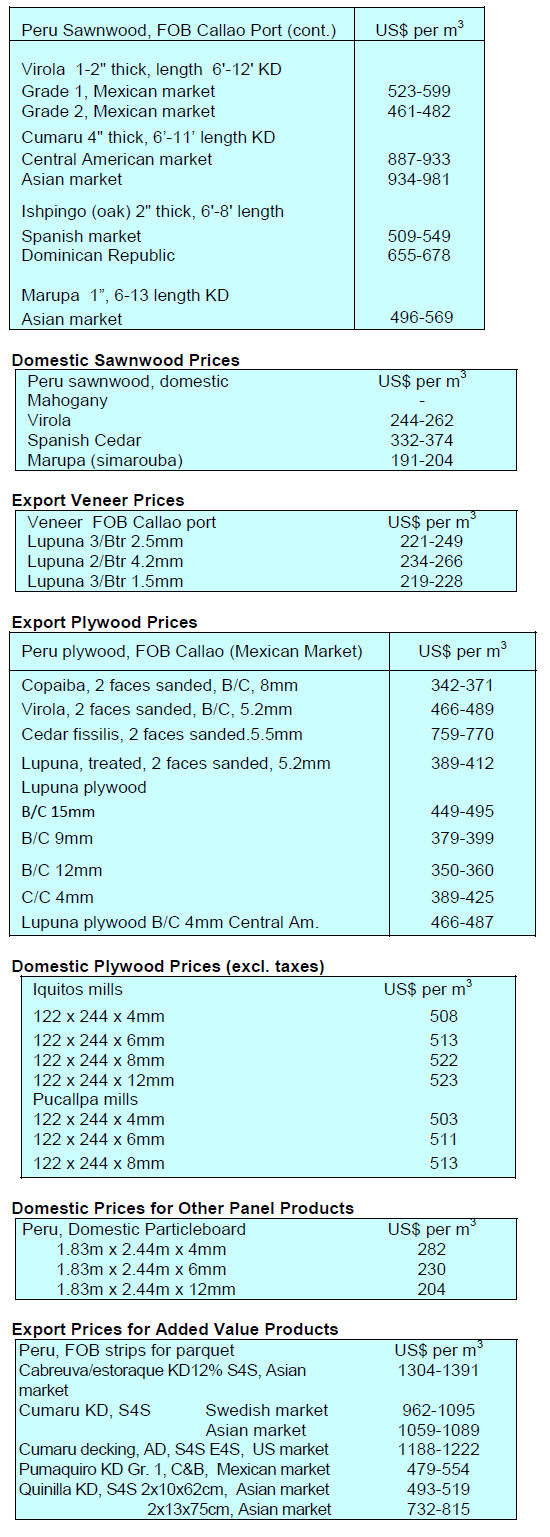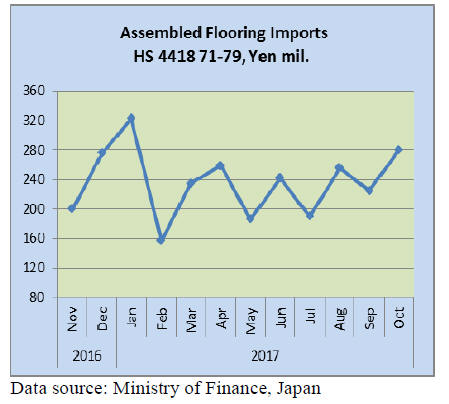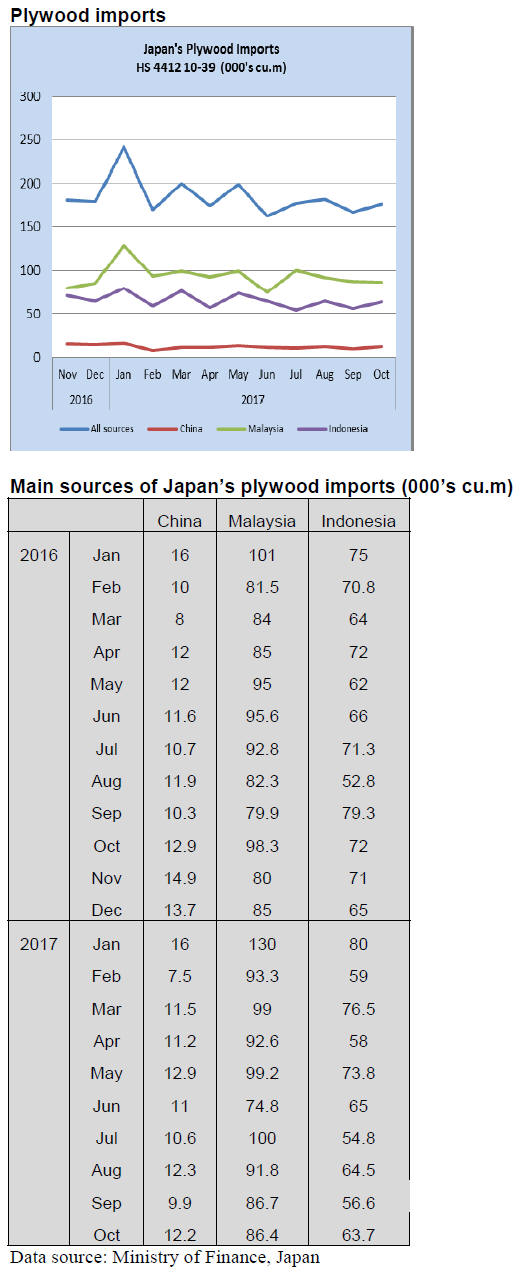2. GHANA
Wood tracking system field tested
The Forestry Commission has begun implementing a
wood tracking system. The system delivers all relevant
data on forest operations in order to track the timber
supply chain to the final point of sale.
The system will help curb illegal logging and the sale of
illegal timber and will eventually enable the country to
issue Forest Law Enforcement Governance and Trade
(FLEGT) licenses under the Voluntary Partnership
Agreement (VPA) between Ghana and the EU.
The system is currently being tested in selected forest
districts in Western, Brong Ahafo, Ashanti and Eastern
regions of the country.
President - businesses will be revived
The new government has been sworn in exactly one month
after Ghanaians gave the opposition the mandate to
manage the affairs of the country.
During his inaugural speech the new President said
Ghanaians should all recognise the danger from the
degradation of the environment and work to protect the
lakes and rivers, the forests, the lands and the oceans. He
said Ghanaians should learn and accept that they do not
own the land, but hold it in trust for generations yet
unborn and, therefore, have a responsibility to take good
care of it.
The full speech can be found at
https://www.youtube.com/watch?v=4n7ZZXcfpWE
New minister announced
Mr John Peter Amewu, the New Patriotic Party Volta
Regional Chairman has been nominated Minister for
Lands and Natural Resources.
Business leads express optimism
The President has assured the business community that
Ghana is open to business again and that businesses will
be revived under his administration. Some of the policy
changes planned include a cut in corporate and value
added taxes anda reduction in interest rates.
Many business leaders have been encouraged by the
expansionary policies of the new administration and are
calling on the new administration to implement businessfriendly
policies to revive the manufacturing sector in
Ghana.
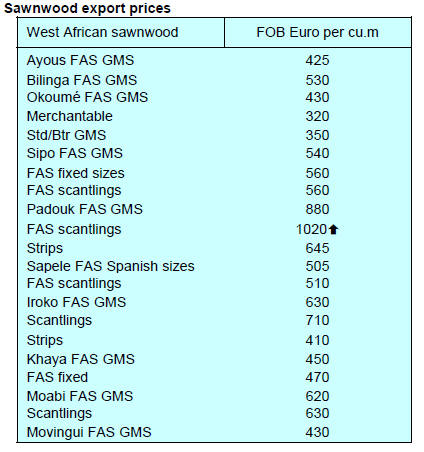
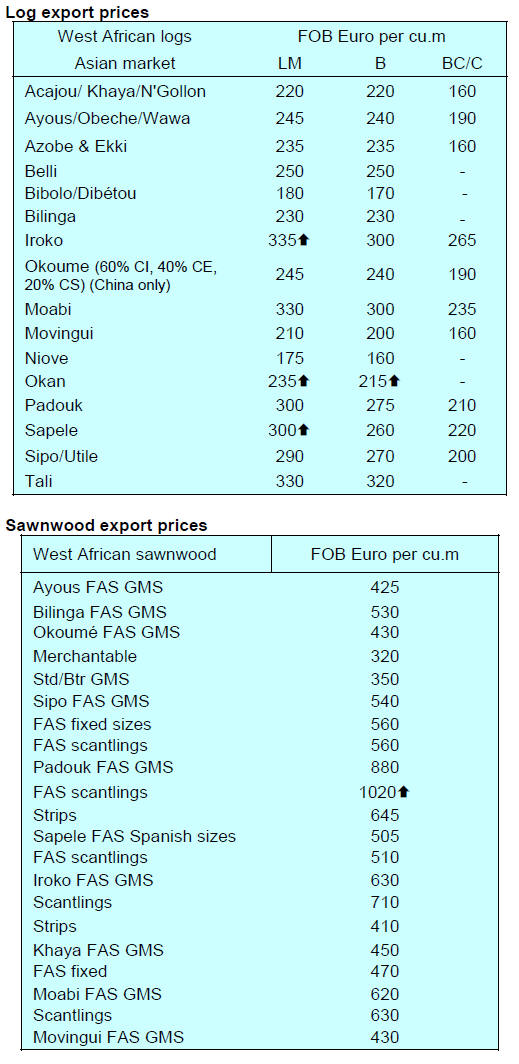
3.
SOUTH AFRICA
Businesses back to work mid-January
The manufacturing and construction sectors in South
Africa stopped work for the Christmas and New Year
festivities in mid-December and only resumed business in
mid-January. Our analysis of the timber market trends in
South Africa will resume at month end.
Warning on structural timber usage
A recent press release from the Institute for Timber
Construction South Africa (ITC-SA) has warned South
African importers and endusers that timbers used in
structural applications must comply with South African
regulations.
Builders in South Africa are currently facing a shortage of
structural timber which has led to an increase in imports.
The ITC-SA says “National building regulations require
that all structural timber comply with SANS 1783, which
covers sawn softwood timber and both national and
international manufacturers of structural timber supplied
to the SA market are expected to be certified by a South
African-based ISO 17065-accredited certification body.”
Only the South African Technical Auditing Services
(SATAS) and the South African Bureau of Standards
(SABS) are accredited to certify manufacturers of products
in compliance with SANS 1783.
See:
http://itc-sa.org/category/press-releases/
Turbulent months ahead for the rand
Several analysts and the World Bank are warning of tough
times ahead for the rand exchange rate.
The consensus is that 2017 will be especially turbulent due
to internal political rivalry as presidential election loom
and due to uncertainty as to how US policies will change.
Nomura Market Research in a recent released suggested
that the rand could lose between 10-12% against the US
dollar in 2017. The World Bank has also issued a warning
that the South Africa currency could come under pressure
in 2017 but still expects the South African economy to
expand by 1.1% in 2017 due to better commodity prices.
Residential activity survey delivers hint of growth
The fourth quarter survey of real estate companies (estate
agents) by First National Bank (FNB) confirmed that
agents have noticed a slightly pick-up in the residential
property market.
FNB produces a residential sector index and in the fourth
quarter 2016 its ‘Residential Activity Indicator’ rose
slightly to 5.75, from the previous quarter’s 5.59. However
this modest rise is only a hint of improvement and a
significant further improvement in activity over the
coming quarters would be needed to be confident of an
improving trend.
http://www.fin24.com/Economy/slight-stir-in-sa-residentialproperty-
market-20170113
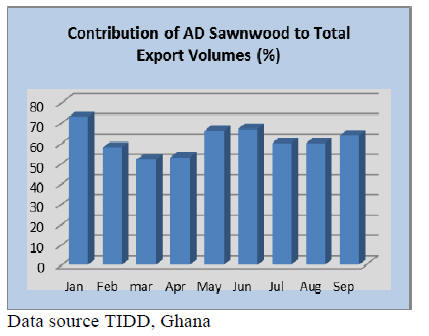
4.
MALAYSIA
US$100 billion Malaysia/China trade
target
China’s Ambassador to Malaysia Dr. Huang Huikang has
said he hopes the bilateral trade between Malaysia and
China could reach the target of US$100 billion this year.
Between January and November last year the bilateral
trade totalled almost US$85 billion.
China has been Malaysia’s largest trade partner for the
past seven years. Malaysia is China’s sixth largest trading
nation in the world. China is now the second largest
foreign investor in Malaysia.
Exports benefit from weakening currency
The Malaysian ringgit has been experiencing continued
weakness in international currency markets for some time
and observers fear further weakening due to both external
and internal issues. The ringgit was at 4.40 to the US
dollar in early January and has been testing the lows seen
during the 1998 Asian Financial Crisis.
Strong dollar boosts earnings in furniture sector
Malaysian furniture exporters have seen revenues and
profit rise over the past few months despite the ongoing
labour shortage due to restrictions on the hiring of foreign
workers. The strengthening of the US dollar has also given
a boost to exporters.
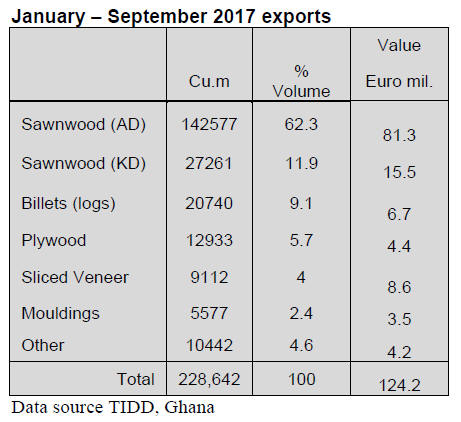
Over the eleven months to November 2016, Sarawak
produced 6,795,434 cu.m logs. Around 2.5% came from
swamp forests with the balance from hill forests. In the
same period in 2015, 7,575,387 cu.m of logs were
produced.
Production of hill logs in between January and November
last year was highest in Sibu (2,848,780 cu.m) with
Bintulu producing 1,828,637 cu.m and Miri 1,791,705
cu.m. Meranti was the predominant hill species produced
(2,309,561 cu.m), Kapur was second (221,742 cu.m) and
third was Keruing (170,810 cu.m).

New MTC Chairperson
In a press release the Malaysian Timber Council (MTC)
has announced the appointment of Dato’ Gooi Hoe Hin as
the new MTC Chairman effective January 1, 2017.
He takes over from Dato’ Sri Wee Jeck Seng. Dato’ Gooi,
who holds a Bachelor of Economics (Hons) from
University Malaya, served as the Private Secretary to the
former Chief Minister of Penang, the late Tun Dr. Lim
Chong Eu, before taking on various posts in the Ministry
of Primary Industries (now known as the Ministry of
Plantation Industries and Commodities).
During his 25 years of government service, Gooi worked
closely with the Ministry of Primary Industries and its
Ministers to develop various far reaching commodities
related policies which were instrumental in protecting the
commodities sectors, particularly palm oil, rubber, timber
and timber products and tin.
See:
http://www.mtc.com.my/images/media/359/PR_Appointment_of
_New_Chairman_for_MTC.pdf
5. INDONESIA
Re-grouping Indonesian timbers
Work has been conducted at the Indonesian Forest
Products Research Center on the basic characteristics of
some readily available lesser used timbers which are
currently traded as Indonesian mixed tropical hardwoods.
It has been suggested that some of these timbers to be
deserve to be upgraded and traded individually.
The timbers of interest are mimba (Azadirachta indica
A.Juss), gopasa (VITEC cofassus Reinw. Ex Blume),
tembesu (Fagraea fragrans Roxb) and penggal buaya wood
(Zantoxylum rhetsum St. Lag). This research was
reported by Dr. Ratih Damayanti, M.Si, a researcher at the
Center.
Ratih explained that from a total of 1,060 timbers included
in the recent study, 40 could be classified in Class
Commercial I, 325 as Commercial II, 53 as Commercial
III, 212 as Commercial IV and 205 as Commercial Class
V. If this upgrading is adopted it will impact royalty
payments and improve government revenue.
For more see:
http://www.forda-mof.org/berita/post/3290
Furniture success in Saudi Arabian exhibition
Indonesian wood and acrylic furniture products made an
impact at the Jeddah International Trade Fair (JITF) 2016,
held 20-23 December at the Jeddah International Trade
and Exhibition Centre, Saudi Arabia.
Indonesian furniture exports to Saudi Arabia have been
increasing steadily and topped US$4.2 million in 2102
rising to US$4.3 million in 2013, US$4.5 million in 2014
and a whopping US$9.5 million in 2015!
New project to Protect Kalimantan Forests
A partnership programme between the US and Indonesian
governments, the Nature Conservancy and the World
Wildlife Fund for Nature, Indonesia has approved grants
worth US$3.3 million for local non-governmental
organizations to work with forest-dependent communities
to conserve tropical forests, protect natural resources and
wildlife and improve community livelihoods.
Extent of forest fires fell in 2016
According to Siti Nurbaya Bakar, Minister of
Environment and Forestry the number and extent of forest
and fires in 2016 fell. Satellite observations over 2016
show the number of ‘hot spots’ was down over 80% year
on year.
Improve infrastructure – the key to list investment
One issue that continues to hold back Indonesia's growth
prospects inadequate infrastructure. In the “World
Economic Forum Global Competitiveness Report”
Indonesia ranks 62nd out of 140 countries in terms of
infrastructure development. While the Indonesian
government is well aware of the need to improve this to
make the country more attractive to investors there are
serious challenges.
A recent article from Indonesia-Investments looks at this
issue and says “- developing Indonesia's infrastructure is
not an easy task. The Archipelago consists of about 17,000
islands which makes it more complex to enhance
connectivity and implies there exists a need to focus on
maritime infrastructure. Currently, sea transport is more
expensive than land transport as the country's sea transport
is yet to be developed substantially.”
The article continues “- decentralisation of power led to
the present situation in which local governments
sometimes fail to support the central government's
infrastructure plans.”
For the full article see: http://www.indonesiainvestments.
com/business/risks/infrastructure/item381
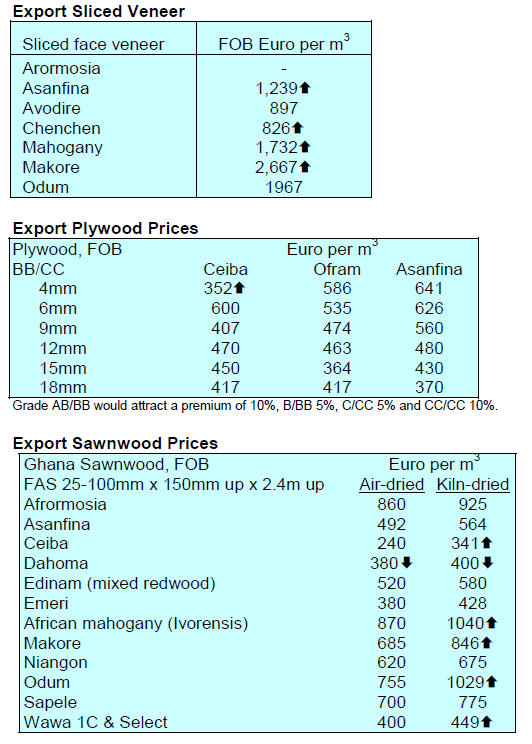
6. MYANMAR
Timber exports highest since log export
ban
Myanmar’s trade deficit reached to US$3.2 billion for the
9 month period April to December 2016, down slightly
from a year earlier.
Exports of wood products, at US$160 million, were the
highest since the log export ban in April 2014. Although
this is a small amount compared to exports from
Myanmar’s neighbours the growth since the log export
ban is significant. The major products exported are teak
sawnwod and ‘mini’ decking used for luxury boats.
Sawnwood export classification
The classification of sawnwood qualities and
specifications in Myanmar is rather unique. The most
common quality is the so-called FEQ (First European
Quality).
There are three major groups of sawn timber: Flitches
(with a cross-sectional area of 24 square inches and up,
excluding heartwood), boards (width 6 inches and wider),
scantlings (width 5 inch or below). In addition to
sawnwood there are two other main marketable items:
outdoor decking and ‘mini-decking’ for yachts. Because
there are restrictions on the maximum size of a flitch that
can be exported flitch production is limited.
Boards and scantling are regularly available and the EU
and US markets prefer long length boards. FOB prices for
these items depend not only quality but also the average
width and length.
The price of boards with an average width (8 inch) and
length (8 ft) can vary from US$ 4100 to 4500 /cu.m.

Export volumes may fall when new regulation
introduced
The MyanmarTimes has reported that a spokesperson from
the Ministry of Natural Resources and Environmental
Conservation, U Win Zaw, has said the volume of timber
that can be exported is likely to decline beginning May
this year.
The news item says “Only timber cut from logs sold by the
state-owned Myanmar Timber Enterprise (MTE) which
contracts out much of its cutting activity is eligible for
export. MTE sells timber monthly through a tender
system, with separate tenders in kyat and US dollars.”
U Win Zaw announced that beginning May 2017 only logs
purchased in US dollars can be processed for export.
http://www.mmtimes.com/index.php/business/24446-resourceministry-
plans-reduction-in-export-eligible-timber.html

7. INDIA
Growth set to slow even before impact of
demonetisation kicks-in
India’s Ministry of Statistics and Programme
Implementation has released economic forecasts for 2016-
17 suggesting the economy will expand at a slightly
slower rate (7.1%) than in the previous fiscal year.
Local analysts were quick to point out that the ministry
forecasts are based on data compiled prior to the decision
on demonetisation, the impact of this on growth prospects
remains very uncertain.
The ministry predicts the agriculture, forestry and fisheries
sectors will expand much more than in the previous period
but growth in mining is set to decline. Growth in
manufacturing and construction is also expected to slow.
See:
http://www.mospi.gov.in/sites/default/files/press_release/n
ad_prn_6jan17.pdf
Inflation rate trends
The Office of the Economic Adviser (OEA) to the Indian
government provides trends in the Wholesale Price Index
(WPI). The official Wholesale Price Index (WPI) for All
Commodities (Base: 2004-05=100) for November 2016
rose by 0.1% to 183.1 from 182.9 for October.
The annual rate of inflation, based on the monthly WPI,
stood at 3.15% (provisional) for the month of November
2016 compared to 3.39% for October.
See:
http://eaindustry.nic.in/cmonthly.pdf
Timber and plywood price indices climb
The OEA also reports Wholesale Price Indices for a
variety of wood products. The Wholesale Price Indices for
Wood products and Plywood are shown below.
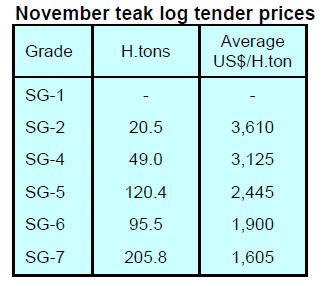
Imported MDF gaining market share
India’s e-magazine Ply-Reporter has suggested that it is
over-capacity in international production of MDF that is
behind the continuing rise in India’s MDF imports.
Despite adequate domestic capacity and antidumping
protection measures low priced imported MDF is gaining
market share.
Data from the Directorate General of Commercial
Intelligence and Statistics, Ministry of Commerce and
Industry shows a 14% rise in 2015-16 MDF imports year
on year. The question that is being asked is that will
domestic manufacturers which have plans to expand MDF
capacity be able to compete with imports.
For the full story see:
http://emagazine.plyreporter.com/01112016/Home.aspx
Export of rosewood musical instrument parts on hold
With all Dalbergia being subject to CITES regulation
Indian manufacturers of rosewood products have had to
cease exports until the Forest Department and CITES
work out the formalities and procedures to be followed.
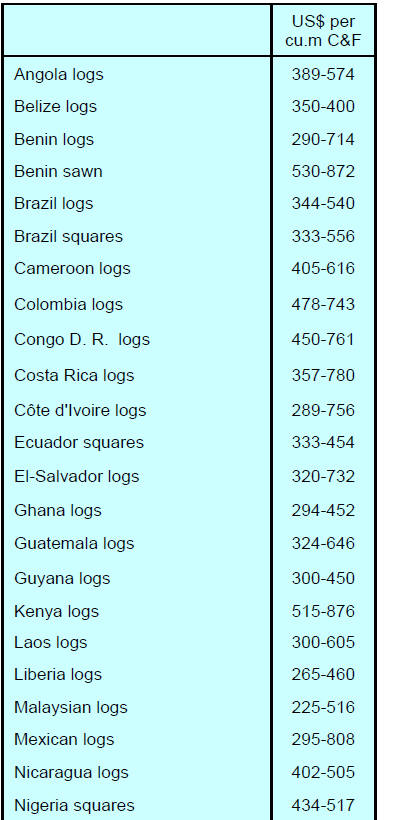
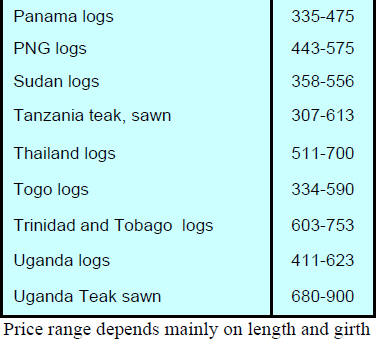
As was the case in November, prices from the new
plantation teak log suppliers remain unchanged at: Taiwan
P.o.C (US$,1036 to 2,126 per cu.m C&F) and Honduras
(US$471 to US$539 per cu.m C&F). Sawn teak from
China (US$855 to 1,118 per cu.m C&F) and from
Myanmar, (US$461-2,895 per cu.m C&F).
Indian importers still hostage to methyl bromide
treatment rules
Demand for imported plantation teak logs and sawnwood
continues to be good and suppliers have been able to ship
larger girth logs in recent months which has given a boost
to demand. Timber importers are still hostage to the
domestic requirement that shipments be treated with
methyl bromide.
Indian plant quarantine rules require that imported timbers
are fumigated with methyl bromide at the port of loading
and a certificate to that effect accompanies the imported
consignment.
However, many countries have banned the use of methyl
bromide so cannot comply with Indian phytosanitary
requirements. Indian authorities are well aware of the
problem but as yet have not suggested an alternative
internationally acceptable treatment. When this issue is
addressed Indian importers would have access to a wider
range of suppliers.
Prices for locally sawn imported timbers
Local analysts report a growing interest in sawn
hardwoods from Sarawak.
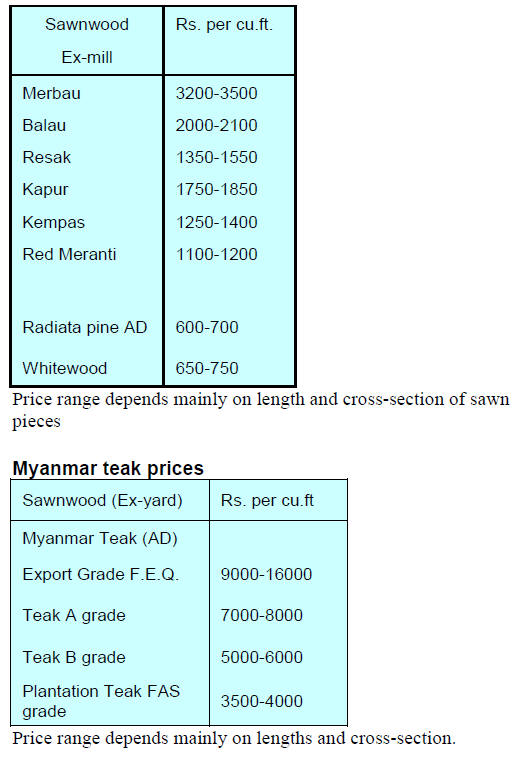
Rising international demand for India’s teak
products
drives up sawnwood imports
The steady supply of imported sawn teak from Myanmar
and China has held prices in check. Indian exporters of
teak products are experiencing increased sales and this has
lifted the volumes of sawn teak shipments.
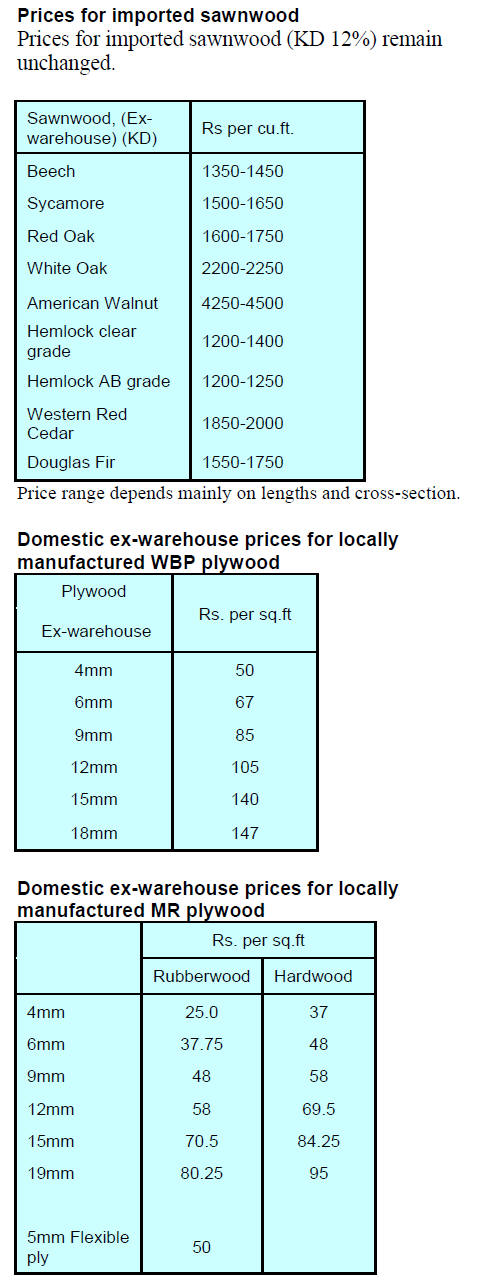
Finally, plywood manufacturers secure price
increase
Plywood manufacturers in Indian have struggled to live
with rising production costs but no opportunity to raise
prices due to the subdued housing sector.
However, over the past months production costs have risen
even higher, mainly due to demonetization say analysts,
resulting in an urgent need to raise prices. The impact of
demonetisation and the slow introduction of the new
Goods and Services tax has created a tough trading
environment in the country.
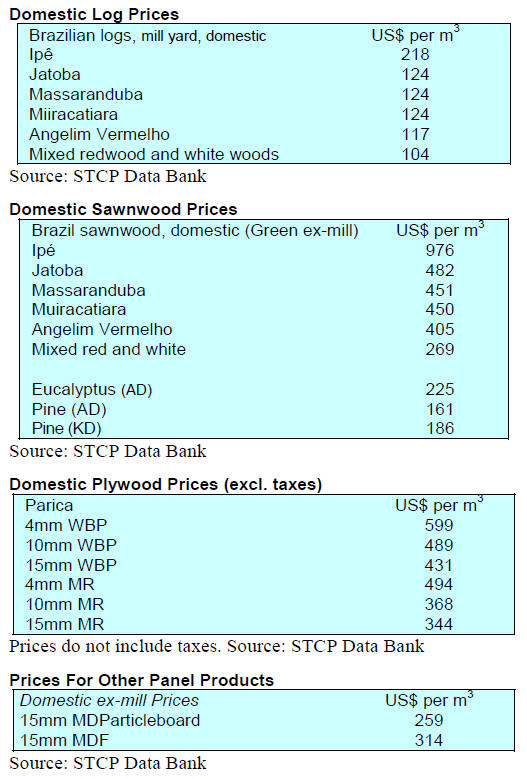
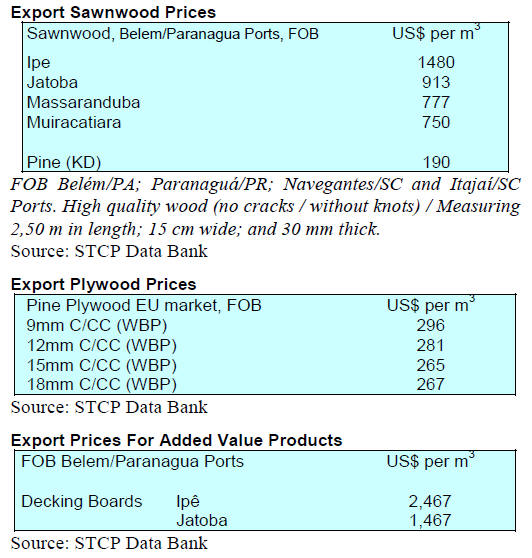
8. BRAZIL
Support for micro, small and medium companies
The Brazilian Development Bank (BNDES) has
announced measures to support micro, small and medium
size companies (M/SMEs). Among the measures that will
be offered beginning this month will be financial support
for investment projects and for the purchase of machinery
and equipment.
Offers of financing will range between R$90 million and
R$300 million and repayments can be spread over 5 to 10
years. Moreover, options for the refinancing of overdue
balances could be made available.
Other measures were also announced by BNDES such as
the launch of an exclusive portal for M and SMEs to
facilitate communication and consultation on product
development and speedier processing of applications.
ABIMCI has said these measures could benefit the wood
based industries.
Importance of the wood industry in the national
economy
The solid wood industry that includes sectors such as
plywood, sawnwood, flooring and other builders
woodwork is set to report a slight rise in 2016 employment
compared to levels in 2015 according to the General
Register of Employed and Unemployed Workers. These
sectors account for just under 60% (369,000) of jobs in the
Brazilian overall forest sector and, accounted for 9% of
the country's total formal employment in 2015.
Throughout 2015 the solid wood industry sectors shed
thousands of jobs but according to the 2016 Sectoral Study
by ABIMCI employment creation accelerated in 2016.
The survey showed that the solid wood sectors had
outperformed the national trend. Although the industry
had to deal with currency fluctuation, high inflation, high
interest rates, increased production and transaction costs
and slow investment the segment closed 2016 on a
positive note.
For 2017 the ABIMCI expects that the reforms and cuts in
public spending announced by the Federal government
could contribute to economic recovery and, consequently,
to improve sentiment and investment.
Furniture export figures from Rio Grande do Sul
The negative performance of the furniture industry in 2016
presented by the Furniture Industry Association of Rio
Grande do Sul (MOVERGS) was the result of weakness in
the domestic as well as international markets.
In September 2016, Brazilian furniture exports totalled
US$51.8 million and in October last year were US$ 53.5
million, both lower than that of August when the sector
registered a small increase, amounting to US$ 53.6
million.
A slight improvement was recorded in November 2016
when exports reached US$ 55.2 million. But overall, from
January to November 2016 exports totalled US$548.2
million, a decline of 0.6% compared to the same period of
2015.
Of total exports 23% went to the United States, 14% the
United Kingdom, 12% to Argentina, 7% to Uruguay and
6% Peru according to the IEMI - Market Intelligence
report based on data from the Ministry of Development,
Industry and Foreign Trade (MDIC).
In terms of ranking the main furniture exporting states in
Brazil in 2016 were Santa Catarina and Rio Grande do Sul
states (35% and 30%, respectively) followed by Paraná in
third place with 13.5%, São Paulo, 13%, and Minas
Gerais, 5%.
Earnings by furniture cluster fall
The Bento Gonçalves Furniture Industry Union
(Sindmóveis) ended 2016 showing major declines in
domestic sales, exports and job creation. The aim of the
Union, which represents about 300 companies, is to now
begin a recovery process through opening new markets in
Brazil and abroad.
A preliminary analysis indicates that, year on year, 2016
revenue earned by the Bento Gonçalves furniture cluster
fell around 18% between January and October.
Exports between January to October 2016 fell 4.6% year
on year and there was an almost 8% decline in the number
of employees in the cluster.
Sindmóveis says that among its members some are
investing in products for new export markets and looking
to modernise production, improve design and test
alternative distribution channels such as e-commerce in an
effort to resume growth.
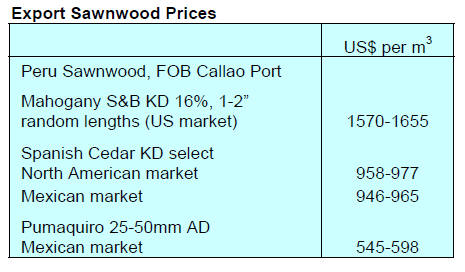
9.
PERU
ADEX anticipates exports fell in 2016
According to Erik Fischer, Chairman of the Committee on
Wood and Wood Industry, ADEX, Peru’s wood product
exports continue to decline. Fischer has estimated that
wood product export shipments in 2016 are likely to be
around US$120 million. At this level they would represent
a 20% year on year decline (2015, US$151.7 million).
For 2017 Fischer anticipates a further 20-30% drop in
wood product export values. The highest value for wood
product exports was achieved in 2007 when they totaled
US$212 million.
Micro furniture enterprises provided with training
Within the framework of a project aimed at improvement
of the productive and commercial management capacities
of the micro-enterprises in the province of Coronel Portillo
and Padre Abad, Ucayali region, the Instituto Tecnológico
de la Producción-ITP (Technological Institute for
Production) in cooperation with CITEFORESTAL
Pucallpa had, by the end of 2016, trained more than 1,500
furniture makers from 182 companies.
The trainings programme focused on topics such as
identification of species, designing, production planning,
cost and quality control, wood drying and finishing.
Vast areas of inoperative forest concessions
According to Julio Ugarte, Director of Studies and
Research for Policy and Competitiveness at the National
Forestry and Wildlife Authority (Serfor), 6,254,183
hectares of forest are the subject of commercial concession
agreements. However, he points out that, to-date, some 5
million hectares of these allocated concessions are
considered inoperative.
According to Alfredo Biasevich, Director of the
Committee for the Timber Sector in the National Society
of Industries (SNI), between 2002 and 2004 concessions
were open to public tendering but many of those granted
concessions were small and medium producers which in
many cases did not have managerial or financial capacity
to operate a concession.
As of November 2016 there were 1,26 million ha. Of
forest designated as conservation, reforestation and
wildlife management areas.
